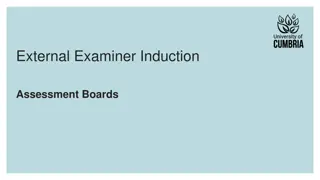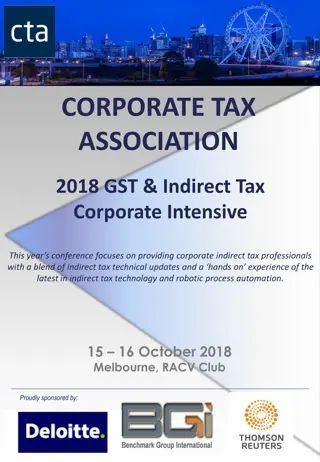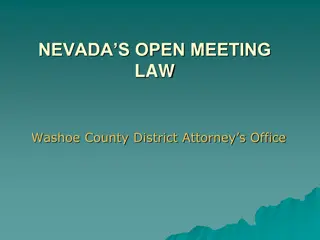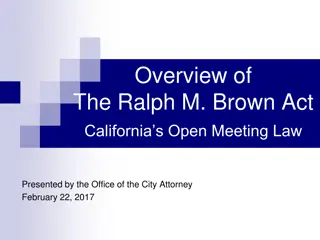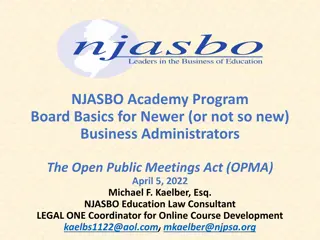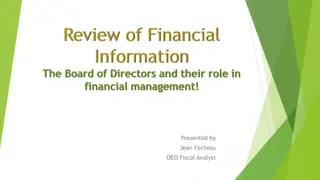Understanding Meetings of the Boards and Its Committees in Corporate Law
Successful companies utilize board meetings to develop and enhance essential business strategies. The board of directors acts as an oversight board, ensuring the protection of non-controlling shareholders' interests and providing strategic guidance to the company. This article discusses the frequency, calling procedures, and quorum requirements for board meetings, emphasizing the importance of creating the right corporate culture.
Download Presentation

Please find below an Image/Link to download the presentation.
The content on the website is provided AS IS for your information and personal use only. It may not be sold, licensed, or shared on other websites without obtaining consent from the author. Download presentation by click this link. If you encounter any issues during the download, it is possible that the publisher has removed the file from their server.
E N D
Presentation Transcript
NAME ARUNAV JOSHI ROLL NO. UI1947300019 SUBJECT CORPORATE OF LAW TOPIC MEETINGS OF THE BOARDS AND ITS COMMITTEE SUBMITTED TO PARSHWA SHAH SIR
MEETINGS OF THE BOARDS AND ITS COMMITTEE Successful companies use board meetings to create and improve key business strategies. The board of directors of a company is primarily an oversight board. It oversees the management of the company to ensure that the interest of non-controlling shareholders is protected. It also functions as advisory board. Independent directors bring diverse knowledge and expertise in the board room and the CEO uses the knowledge pool in addressing issues being faced by the company. The most important function of a monitoring board is to provide direction to the company. Another very important function of a monitoring board is to set the tone at the top . It is expected to create the right culture within the company.
MEETINGS OF THE BOARD 1. Frequency of Meeting: First Meeting : First Meeting of Board of Directors within 30 (Thirty) days from the date of Incorporation of company. Subsequent Meetings: One person Company, Small company and Dormant company: -At least one meeting of Board of directors in each half of calendar year. - Minimum Gap B/W two meetings at least 90 days. Other than Companies mentioned above: - Minimum No. of 4 meetings of Board of Director in a calendar year. - Maximum Gap B/W two meetings should not be more the 120 days.
2. Calling of Meeting: Meeting of Board of Director should be called by giving 7 days notice to Directors at his registered address through: - By hand delivery - By post - By Electronic means Meeting at shorter Notice: A meeting of Board of Directors can be called by shorter notice subject to the conditions: If the company is require to have independent director: Presence of at least one Independent director is required. In case of absence, decision taken at such meeting shall be circulated to all the directors, and Shall be final only on ratification thereof by at least one Independent Director. If the company doesn t require to have independent director: The meeting can be called at a shorter notice without any conditions to be complied with.
3. Quorum of Board Meeting: 1/3 rd of total strength OR 2 (Two) Directors, whichever is higher. Where meeting of Board could not be held for want of quorum, the meeting shall automatically adjourn to same time, same place at next week (Not being national holiday). If number of directors reduced below quorum, then the remaining directors may hold the meeting for the following purposes: To call a General meeting Increase the number of directors. Quorum in case of Interested Directors: If interested director exceed or equal to 2/3 of total strength the remaining directors not being less than 2 (two) shall be the quorum.
4. Participation of Directors in Board Meetings: Directors may, apart from attending the meeting physically, participate in the meeting by way of video conferencing & other audio visual means. Matter which can t be dealt at a meeting held though Video conferencing: Approval of the annual financial statements; Approval of the Board s report; Approval of the prospectus; Audit Committee Meetings for consideration of accounts; and Approval of the matter relating to amalgamation, merger, demerger, acquisition and takeover. Procedure for conducting of meeting through Video Conferencing: Requirements before Meeting: A director intending to participate through video conferencing or audio visual means shall communicate prior intimation sufficiently in advance to the Chairperson or the company secretary of the company, so that company is able to make suitable arrangements in this behalf. Alternatively a director may intimate at the beginning of the calendar year his desire, to participate through the electronic mode, which shall be valid for that calendar year
5. Passing of Resolution by Circulation: A company may get approval on a resolution by Board of Director without conducting a board meeting; company can do it by passing of resolution by circulation. PROCEDURE OF PASSING OF RESOLUTION BY CIRCULATION: I . The company will circulate draft resolution along with necessary papers, if any to all the directors at their registered address through: - Hand Delivery - Post - Electronic Means II. Resolution should be approved by majority of Directors, who are entitled to vote on the resolution. III. Resolution passed by circulation shall be noted at a subsequent meeting of the Board and made part of the minutes of such meeting.
6. POWER EXERCISABLE BY BOARD: The Board of Directors of a company shall be entitled to exercise all such powers, and to do all such acts and things, as the company is authorized to exercise and do. In exercising such power or doing such act or thing, the Board shall be subject to the provisions of this Act, or the memorandum or articles, or regulations made by the company in general meeting: POWERS TO BE EXERCISED ONLY AT BOARD MEETING: UNDER THE ACT: Make calls on shareholders in respect of money unpaid on their shares; Authorize buy-back of securities under section 68; Issue securities, including debentures, whether in or outside India; Borrow monies; Invest the funds of the company; grant loans or give guarantee or provide security in respect of loans; Approve financial statement and the Board s report; Diversify the business of the company; Approve amalgamation, merger or reconstruction; Take over a company or acquire a controlling or substantial stake in another company;
UNDER RULES: Make political contributions; Appoint or remove key managerial personnel (KMP); Take note of appointment(s) or removal(s) of one level below the Key Management Personnel; Appoint Internal auditors and secretarial auditor; Take note of the disclosure of director s interest and shareholding; Buy, sell investments held by the company (other than trade investments), constituting five percent or more of the paid up share capital and free reserves of the investee company; Invite or accept or renew public deposits and related matters; Review or change the terms and conditions of public deposit; Approve quarterly, half yearly and annual financial statements or financial results as the case may be.
COMMITTEES: MANDATORY COMMITTEES AND THEIR THRESHOLDS & COMPOSITIONS: 1. AUDIT COMMITTEE: Meeting of Audit Committee: -Audit Committee should meet at least four times in a year. - Maximum Gap between 2 Meetings is 4 Months. - Minimum 2 Director must be present.
COMPOSITION OF AUDIT COMMITTEE: 1. THE FREQUENCY OF AUDIT COMMITTEE IS PROVIDED AS PER REVISED CLAUSE 49 OF LISTED AGREEMENT (Applicable from 1st October 2014)
2. Chairman of the Audit Committee shall be present at Annual General Meeting to answer shareholder queries. 3. The Auditor of a company and the key managerial personnel shall have a right to heard in the meeting of audit committee when it consider the auditor s report but shall not have right to vote. 4. VIGIL MECHANISM: Every LISTED company and company, which has: -Accepted deposits from public; - Borrowed money from Bank and Public Financial Institution in excess of Rs. 50 crore shall establish a Vigil Mechanism. The Mechanism shall, be established for director and employee to report genuine concerns and also provide for adequate safe guards against victimization of persons using such mechanism. The companies which are required to constitute an audit committee shall oversee the vigil mechanism through the committee and if any of the members of the committee have a conflict of interest in a given case, they should reuse themselves and the others on the committee would deal with the matter on In case of other companies, the Board of directors shall nominate a director to play the role of audit committee for the purpose of vigil mechanism.
2. NOMINATION & REMUNERATION COMMITTEE: COMPOSITION OF REMUNERATION & NOMINATION COMMITTEE:
The Chairman of the nomination and remuneration committee could be present at the Annual General Meeting, to answer the shareholders queries. NO SPECIFIC FREQUENCYOF MEETING OF NOMINATION & REMUNERATION COMMITTEE PROVIDED UNDER THE ACT. GESTATION PERIOD FOR AUDIT, NOMINATION & REMUNERATION COMMITTEE: According to the Companies (Meeting and Powers of Board) Amendment Rules, 2014 companies which were not required to have Audit Committee under CA- 1956, but required under CA-2013 shall constitute the same within one year from 12thJune, 2014 or appointment of independent director,whichever is earlier. Similarly, Public Companies which are required to have Nomination & Remuneration committee under CA-2013 shall constitute the same within one year from 12thJune, 2014 or appointment of independent director, whichever is earlier.
3. STAKEHOLDERS RELATIONSHIP COMMITTEE: Every company having more than 1000 (One thousand) Share Holders + Debenture Holders + Deposit Holders + Other Security Holders shall constitute a Stakeholders Relationship Committee, which shall consider & resolve the grievance of security holders. COMPOSITION: Chairperson: Non-Executive Director Members: As may be decided by the Board
4. CORPORATE SOCIAL RESPONSIBILITY COMMITTEE: Every Company: Having net worth of Rs. 500crore or more, or Turnover of Rs. 1000crore or more or a Net profit of Rs. 5crore or more during any financial year shall constitute a Corporate Social Responsibility Committee of the Board. COMPOSITION OF COMMITTEE: At least 3 (three) directors, out of which at least 1 (one) director shall be an Independent Director. In case of UNLISTED PUBLIC COMPANY Not required to have an Independent Director, the committee can be constituted without an Independent Director. In case of PRIVATE COMPANY, the committee can be constituted without an Independent Director. Further, in case of a Private Company having 2 (two) Directors, the committee can be constituted with only 2 (two) Directors.










